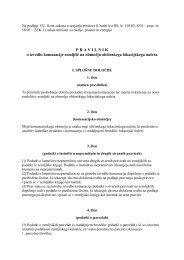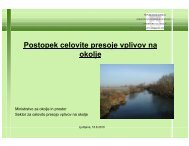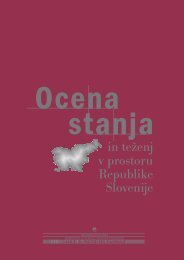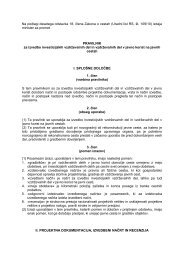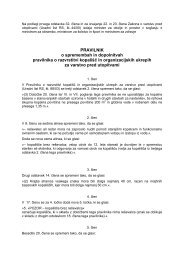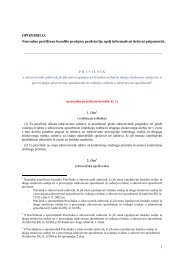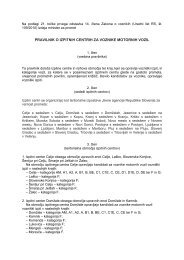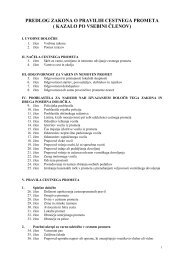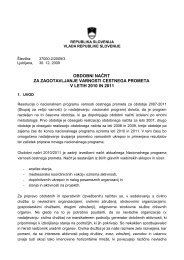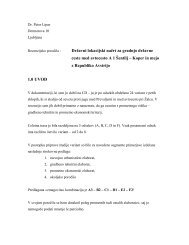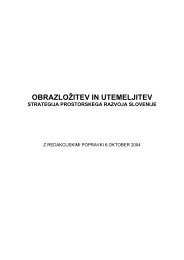evropska konvencija o krajini - Ministrstvo za infrastrukturo in prostor
evropska konvencija o krajini - Ministrstvo za infrastrukturo in prostor
evropska konvencija o krajini - Ministrstvo za infrastrukturo in prostor
You also want an ePaper? Increase the reach of your titles
YUMPU automatically turns print PDFs into web optimized ePapers that Google loves.
Pri razvijanju Evropske konvencije o kraj<strong>in</strong>ah seje po mojem mnenju stalno treba <strong>za</strong>vedatizmuzljivosti <strong>prostor</strong>ske podobe. Vedno jeprisoten razkorak med stvarnostjo <strong>in</strong> podobo –načela, pove<strong>za</strong>na z idelalno podobo kraj<strong>in</strong>e, nisov skladu z aktualno družbeno prakso. Rečeno zjezikom mita: priča smo razkoraku medresničnostjo <strong>in</strong> resnico, med stvarnim razvojem<strong>prostor</strong>a <strong>in</strong> ideološko zgodov<strong>in</strong>o kraj<strong>in</strong>e. Zato jesmiselno loviti ravnotežje med željo popoenotenjem postopkov, ki bodo uravnaval<strong>in</strong>ačrtovanje <strong>in</strong> ravnanje s kraj<strong>in</strong>ami, <strong>in</strong> med<strong>za</strong>vestjo, da so kraj<strong>in</strong>e večkrat celo bolj kulturnikonstrukti kot naravni fenomeni, čeprav enidrugih ne izključujejo. Kajti ti kulturni konstruktiveč<strong>in</strong>oma izhajajo iz zelo prv<strong>in</strong>skega odnosamed človekom <strong>in</strong> naravo. Četudi je, vsaj odrazsvetljenstva dalje 13 , vsa zgodov<strong>in</strong>a kraj<strong>in</strong>e na<strong>za</strong>hodni polobli videti kot brezkompromisnoizkoriščanje, v katerem so absolutni določevalecvrednosti merske enote <strong>in</strong> ne spom<strong>in</strong>, je vendarsmiselno podvomiti v neizpodbitnostmedsebojno izključujočega se značaja evropskekulture <strong>in</strong> narave <strong>in</strong> izpostaviti moč pove<strong>za</strong>v, kiju vežejo, <strong>za</strong>govarja Schama 14 . Kulturnadedišč<strong>in</strong>a na tem delu sveta, je zgrajena, prostopo Thoreauju, na temeljih <strong>za</strong>hodne kraj<strong>in</strong>skedomišljije, ki si je <strong>za</strong>mišljeni rodovitni svetustvarila iz naravnih prv<strong>in</strong>, gozdov, voda <strong>in</strong> skal<strong>in</strong> je pod površje današnje navidezne stvarnost<strong>in</strong>aših kraj<strong>in</strong> pretihotapila svoje z divj<strong>in</strong>o <strong>in</strong>pristno naravo najbolj pove<strong>za</strong>ne mite.Našteto naš odnos do kraj<strong>in</strong> seveda <strong>za</strong>pleta <strong>in</strong>mu manjša preglednost. Prav tako kot mitološkiparts. Because the consciousness is a subject ofchange, the spatial conception is changeable aswell, even when, as proven <strong>in</strong> the case ofSlovenia, certa<strong>in</strong> features persist despite thesocial change 11 . It bears importance for spatialplanners from two po<strong>in</strong>ts of view. First, selectedfeatures, patterns and landscape types are trulyimportant for social identification and should beacknowledged <strong>in</strong> plann<strong>in</strong>g spatial changes. Secondly,the manipulation of the spatial identitythat occurs on the national level can be counterproductive.Creat<strong>in</strong>g an unrealistic image ofspace and becom<strong>in</strong>g <strong>in</strong>fatuated with it can blurthe vision and bl<strong>in</strong>d us to serious problems <strong>in</strong> theenvironment 12 . Therefore, it makes no sense tolimit the spatial identity only to the componentsestablished as national symbols dur<strong>in</strong>g periodsof endeavours for nationhood. Knowledge aboutthe processes of establish<strong>in</strong>g the social conceptionof space is certa<strong>in</strong>ly useful <strong>in</strong>formation ifonly to be constantly questioned, by every s<strong>in</strong>glespatial <strong>in</strong>tervention.When evolv<strong>in</strong>g European landscape conventionthe ambiguity of the spatial image should constantlycome to m<strong>in</strong>d. There is always a discrepancybetween the reality and the image. Thepr<strong>in</strong>ciples l<strong>in</strong>ked to the ideal conception of spacedo not match actual social practice. To put <strong>in</strong> thelanguage of myth, we are deal<strong>in</strong>g here with adiscrepancy between reality and truth, a discrepancybetween the real development of thecountry and the ideological history of the landscape.The effort to tune the processes , whichwould rule the European spatial plann<strong>in</strong>g and51Delavnica 1 / Workshop 111Kont<strong>in</strong>uiteti pojavljanja izbranih delov <strong>prostor</strong>a v kolektivnem spom<strong>in</strong>u lahko sledimo v briljantnem delu Simona Schame, Landscape and Memory (NewYork, 1995), ki razkriva, da pod površjem naših vsakdanjih, samoumevnih predstav o <strong>kraj<strong>in</strong>i</strong> <strong>in</strong> z njimi pove<strong>za</strong>nimi predstavami o varstvu kraj<strong>in</strong>e ležijonajbolj prv<strong>in</strong>ski miti o naravi, strahovi <strong>in</strong> obsesije, <strong>in</strong>, prosto po Levy-Straussu, tudi »divja misel«.The cont<strong>in</strong>uous appearance of certa<strong>in</strong> parts of space <strong>in</strong> the collective memory can be traced <strong>in</strong> the brilliant work of Simon Schama, Landscape and Memory(New York, 1995). The book reveals how under the surface of our conventional conceptions of landscape and its protection thrive most ancient myths aboutwildness and nature, fears and obsessions.12Aktualen primer v Sloveniji je trenutno ravnanje vlade s kulturno kraj<strong>in</strong>o Lipice, ki se je izoblikovala skozi skoraj petstoletno vzrejo lipicancev na tem deluSlovenskega Krasa. Lipica je kot izjemna kulturna kraj<strong>in</strong>a <strong>za</strong>konsko <strong>za</strong>ščitena kot spomenik državnega pomena, vendar ji grozi uničenje, ki ga vlada ne lepodpira, temveč je celo njegov glavni akter, saj svojim ciljem ustrezno sprem<strong>in</strong>ja <strong>za</strong>kone, ki uravnavajo delovanje znotraj <strong>za</strong>ščitenega območja (trenutnoZakon o Kobilarni Lipica). Delno se prej nemaren <strong>in</strong> zdaj aroganten odnos da razložiti prav s tem, da Lipica kot posebna, izjemna kraj<strong>in</strong>a, nikoli ni imelapriložnosti, da bi vstopila v nacionalno podobo <strong>prostor</strong>a. Ker je delovala kvečjemu kot simbol neke preživele monarhije, vanjo na ravni nacionalneidentifikacije nikoli ni bil »<strong>in</strong>vestiran smisel«, kot je bil na primer v kraj<strong>in</strong>o Blejskega jezera.Currently <strong>in</strong> Slovenia the case is a treatment of the cultural landscape of Lipica, which developed through the almost five hundred years long breed<strong>in</strong>g of theLipiz<strong>za</strong>ner horse <strong>in</strong> this part of Slovenian Karst. Lipica is legally protected as a monument of national importance and is proposed to the UNESCO’s list ofworld monuments. It is fac<strong>in</strong>g demolition (transformation <strong>in</strong>to a golf-course), which is not only supported by the present government, but by chang<strong>in</strong>g thelegislation, which governs the management with<strong>in</strong> the protected area, to suit its current goals, the present government is even the ma<strong>in</strong> promoter of thisunacceptable change. Even before the governmental stand towards Lipica was rather negligent and this, as well as current arrogant stand can be expla<strong>in</strong>edby the fact, that Lipica never really get the opportunity to enter the social conception of national space. At most the symbol of some long outlived monarchy itwas never <strong>in</strong>vested with mean<strong>in</strong>g on the level of national identification, as the landscape of Bled and its lake def<strong>in</strong>itely was.13Za nekatere zgodov<strong>in</strong>arje se je na Zahodu ključni odmik od sožitja z naravo zgodil že v renesansi, <strong>za</strong> druge je »kriv« razvoj znanosti v 16. <strong>in</strong> 17. stoletju, ki jenaš planet, pod predpostavko, da je neusahljiv vir, obsodil na brezkompromisno izkoriščanje. Razlago najdemo v Carol<strong>in</strong>e Merchant, Radical Ecology: TheSearch for a Livable World (New York and London, 1992). Prvi krivec <strong>za</strong> dihotomijo narava - kultura je menda iznajdba pluga v 7. stoletju našega štetja, k<strong>in</strong>aj bi kmetovanje spremenila v ekološko vojno, kar v prepričljivi kritiki standardnega razumevanja opozicije znanost – narava ovrže David Rothenberg,Hand’s End: Technology and the Limits of Nature (Berkely and Los Angeles, 1993).For some historians the key split between nature and culture happened <strong>in</strong> the Renaissance, for others it is the scientific revolution of the sixteenth andseventeenth century. Explanations can be found <strong>in</strong> Carol<strong>in</strong>e Merchant, Radical Ecology: The Search for a Livable World (New York and London, 1992). As the»guilt« for the dichotomy between nature and culture is also assigned to the <strong>in</strong>vention of the fixed-harnessed plow, which turned farm<strong>in</strong>g <strong>in</strong>to ecological war,a persuasive and subtle critique of standard opposition between science and nature is provided <strong>in</strong> David Rothenberg, Hand’s End: Technology and the Limitsof Nature (Berkely and Los Angeles, 1993).14Glej Simon Schama, Landscape and Memory (New York, 1995).Simon Schama, Landscape and Memory (New York, 1995).




